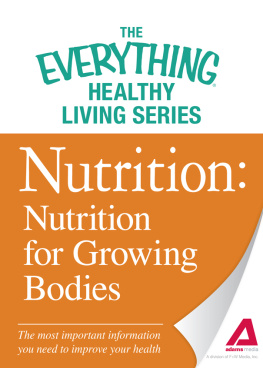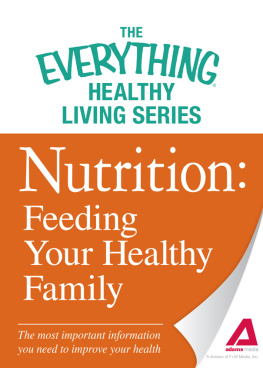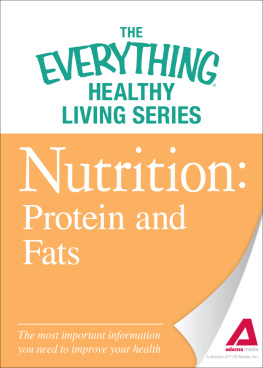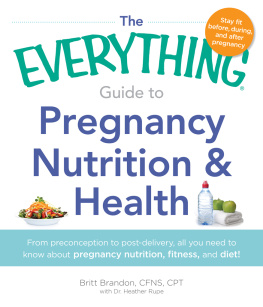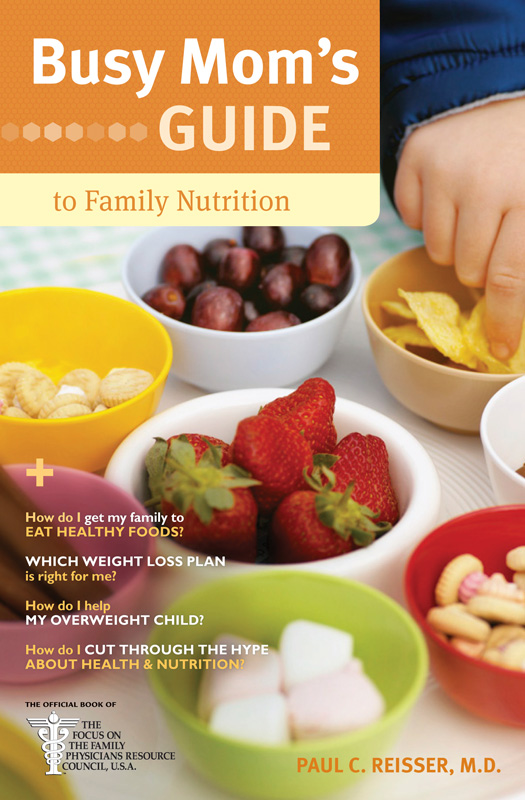The information contained in this book provides a general overview of many health-related topics. It is not intended to substitute for advice that you might receive from your childs physician, whether by telephone or during a direct medical evaluation. Furthermore, health-care practices are continually updated as a result of medical research and advances in technology. You should therefore check with your childs doctor if there is any question about current recommendations for a specific problem. No book can substitute for a direct assessment of your child by a qualified health-care professional.
Visit Tyndale online at www.tyndale.com.
Visit Focus on the Family at www.FocusOnTheFamily.com.
TYNDALE and Tyndales quill logo are registered trademarks of Tyndale House Publishers, Inc.
Focus on the Family and the accompanying logo and design are federally registered trademarks of Focus on the Family, Colorado Springs, CO 80995.
Busy Moms Guide to Family Nutrition
Copyright 2012 by Paul C. Reisser. All rights reserved.
Edited by Dana Niesluchowski; produced with the assistance of The Livingstone Corporation.
Adapted from the Complete Guide to Family Health, Nutrition, and Fitness , ISBN 978-0-8423-6181-1. Copyright 2006 by Tyndale House Publishers, Inc.
Cover photograph copyright moodboard Photography/Veer. All rights reserved.
Designed by Jennifer Ghionzoli
Scripture taken from the Holy Bible, New International Version , NIV . Copyright 1973, 1978, 1984 by Biblica, Inc. Used by permission of Zondervan. All rights reserved worldwide. www.zondervan.com.
Library of Congress Cataloging-in-Publication Data
Reisser, Paul C.
Busy moms guide to family nutrition / Paul C. Reisser.
p. cm. -- (Complete guides)
Adapted from the Complete guide to family health, nutrition, and fitnessT.p. verso
Includes bibliographical references (p. ) and index.
ISBN 978-1-4143-6460-5 (sc)
1. Families--Health and hygiene. 2. Nutrition. I. Reisser, Paul C. Complete guide to family health, nutrition & fitness. II. Title.
RA777.7R35 2012
613.2--dc23 2011052926
Foreword
Fifty years ago, popular visions of the world of tomorrow included not only flying cars and routine trips to outer space, but also twenty- to thirty-hour workweeks and a bounty of leisure time for everyone by the end of the twentieth century. Instead, a decade into the twenty-first century, we are dealing with exponential increases in the complexity of our lives. Were working harder than ever to earn a living while juggling family responsibilities and a multitude of other commitments. Even when were supposedly off duty, there are always dozens of e-mails to wade through, cell phones ringing at all hours, and social networking sites beckoning night and day.
Furthermore, if we need information about anything, our favorite search engine will be happy to summon more websites than we can possibly visit. Yet this overabundance of information doesnt always satisfy our need for wisdom and insightespecially when dealing with issues related to health and nutrition. Indeed, it seems as if every day arrives with news of a dire warning about a food we once thought was perfectly good for us, or a surefire way to lose weight, or a must-have dietary supplement that costs $29.99 per month but will make us feel like a million bucks. How do we sort it all out?
For more than three decades, Focus on the Family has been a trusted resource for input and advice on parenting, marriage, and virtually any other subject that impacts families, including health. A few years ago, I had the privilege of serving as the primary author of the Complete Guide to Family Health, Nutrition, and Fitness , a product of Focus on the Familys Physicians Resource Council. I can say without hesitation that we took the word complete literally, addressing a vast number of topics, including health screening, basic nutrition, weight loss, exercise, emotional concerns, sleep, fatigue, sex, and many more. At one thousand pages, this was not a book to tuck into a handbag for a casual read over lunch. Because busy schedules arent always compatible with the task of sifting through good and bad advice on the Internet or wading through the contents of a large book, we thought it would be helpful to distill the Complete Guide s core concepts about nutrition and weight loss into a smaller volume, and update a few things while we were at it.
Our approach has been to start and stay with the basics, laying down principles that you can adapt to your familys life and tastes. We have framed key ideas in the form of questions and answers, and we have included a lot of practical advice while trying to avoid a cookbook approach (no pun intended) to this often-bewildering topic. If youre looking for quick fixes, youve picked up the wrong book. But if you want to get some news you can use, youve come to the right place.
This book is one in a series of Busy Moms Guides, all of which are intended to provide help and hope for important concerns of family life. By the way, we would be very pleased if these guides would prove useful to some busy dads as well.
Paul C. Reisser, M.D.
December 2011
Chapter 1
Nutritional Basics
Have you ever said to yourself:
Sure, Id like my family to eat a healthier diet, but what does that really mean?
I know I should read food labels in the grocery store, but what exactly am I looking for?
Every month someone seems to come out with a new, surefire way to lose weight. Ive tried most of them without success. What am I doing wrong?
My kids gravitate toward fast food. How can I help them develop better eating habits?
If youve been stymied by issues like these, I encourage you to read on. This book will help you make better-informed decisions about the foods you buy and prepare for yourself and your family. It should also help you better understand food labels and evaluate extravagant claims that are often made for diets or supplements.
Vince Lombardi, legendary coach of the Green Bay Packers, started every training season by announcing, Gentlemen, this is a football. In that spirit, we begin our overview of nutrition with the fundamentals.
What is a nutrient?
If you stop and think about it, the utilization of food by our bodies is an incredible accomplishment and a marvelous feat of engineering. An enormous number and variety of substances that we chew and swallow (usually with some pleasure) are broken down into basic components that serve three general purposes:
1. To provide a steady supply of fuel for thousands of mechanical, electrical, and chemical processes that go on twenty-four hours a day
2. To build, maintain, and repair structures of incredibly diverse shapes, sizes, and constituents
3. To provide some degree of protection against certain destructive processes
We may buy the best fuel and additives for our car, but they can only power the engine and perhaps reduce some wear and tear. A vehicle that could take gasoline and other raw materials and then repair itself exists only in the realm of fantasy. The fact that our bodies do all of this and more without our awareness, supervision, or understanding is truly mind-boggling.
There are six types of nutrients: carbohydrates, fats, proteins, vitamins, minerals, and water. The first three are called macronutrients because we use them in substantial quantities. They are also known as energy-yielding nutrients because they provide the fuel we need for all of our bodily functions. Vitamins and minerals are called micronutrients because of the tiny amounts that we use. They do not provide any energy, but they play a number of important roles in releasing and regulating it. Macronutrients and vitamins are called organic compounds. The word organic has acquired all sorts of meanings over the years (such as natural or unadulterated) but it simply means that the substance contains carbon, the element found in every living thing. Minerals and water are inorganic, though no less important (or natural).


